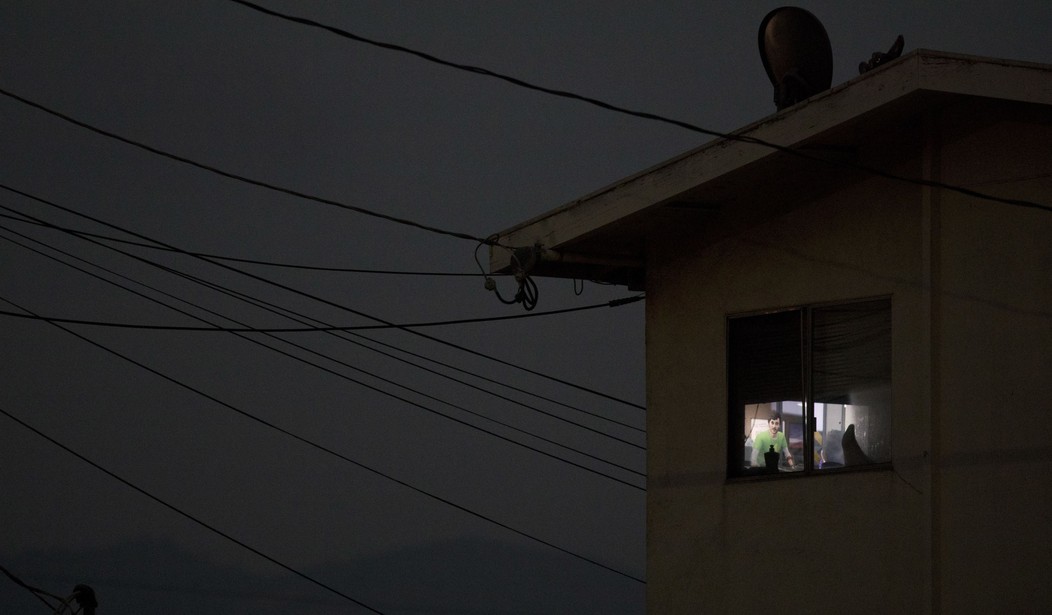And who needs the go-juice in the walls?
Why, only everyone!
But in the formerly Golden State, what was once a "utility" - a necessity for a comfortable life, something every household had and everyone took for granted - has become a commodity and a privilege to pay dearly for even as it becomes a question of when and if it's available.
The blame for most of this can be dumped on the climate cultists' rush to renewables. There has been a pathological antipathy to just-in-case prudence as far as husbandry of existing power resources like nuclear or natural gas and a disastrous enviro-weenie aversion to fire-prevention maintenance under transmission lines. Governor Gavin Newsom's insistence on a NetZero state target of 2035 has shoved it all forward relentlessly.
All the state does in response to the ensuing and entirely predictable snafus is play whack-a-mole.
Witness their latest plan for "restructuring" their skyrocketing electric bills in order to make them more "equitable." And, yes - kilowatts apparently behave differently depending on what socio-economic strata the walls they come through are built for.
Bet you didn't know that.
This all started last year when the three electric companies soaking rate-payers in the state decided it didn't look good to force lower-income folks out of their homes over electric bills. So they came up with a truly novel idea: income-based electricity fees.
...Typically what you pay for electricity depends on how much you use. But the state’s three largest electric utilities — Southern California Edison Company, Pacific Gas and Electric Company and San Diego Gas & Electric Company — have proposed a plan to charge customers not just for how much energy they use, but also based on their household income. Their proposal is one of several state regulators received designed to accommodate a new law to make energy less costly for California’s lowest-income customers.
Paying for electricity you use is "unjust," according to the utilities, because electricity usage among varying income level households is "different..."
...Utilities say that part of customers’ bills still will be based on usage, but the other portion will reduce costs for lower- and middle-income customers, who “pay a greater percentage of their income towards their electricity bill relative to higher income customers,” the utilities argued in a recent filing.
They said the current billing system is unjust, regressive and fails to recognize differences in energy usage among households,
...so the "rich" should pay more.
...James Sallee, an associate professor at UC Berkeley, said the utilities’ prior system of billing customers mostly by measuring their electric use to pay for what are essentially fixed costs for power is inefficient and regressive.
The proposed changes “will shift the burden, on average, to a more progressive system that recovers more from higher income households and less from lower income households,” he said.
I'm assuming that makes sense in a progressive world, as it makes absolutely no sense to me other than the standard socialist soak-the-rich gambit.
The state utility board has until June of this year to decide thumbs up or down. As of last fall, the rich folk hating Democrats populating the state house in Sacramento all thought this was a capital idea, so they enthusiastically voted, "Hay-yull, yeah!"
The few Republicans in state office did point out problems with the scheme. Like, why is anyone going to turn off the A/C and suffer if their bills are going to stay the same? Why conserve at all? And now utilities are also the IRS, having to monitor income statements to know what to charge whom?
...Another major issue: data collection. To implement the changes, the state will have to categorize approximately 14 million households into income brackets, and a third-party administrator probably will have to verify their incomes, state and utilities officials say.
No worries. Planning charged ahead, and a finished rate plan has emerged from the bowels of the state brain trust for California Public Utility Commissioners (CPUC) to approve.
...The California Public Utilities Commission (CPUC) has until July 1 to impose the new rate structure. The state's three main utilities — Pacific Gas and Electric, Southern California Edison and San Diego Gas and Electric — proposed a tiered rate plan.
Households earning $28,000-$69,000 would be charged an extra $20 to $34 per month. Those earning $69,000-$180,000 would pay $51 to $73 per month, and those earning more than $180,000 would pay a $85-to-$128 monthly surcharge.
That's a lot considering California’s electricity rates are already among the highest in the nation. People living in California have been paying 32 cents per kilowatt-hour compared to the national average of 18 cents, according to Energy Sage, which has monitored energy prices nationwide. It claimed California residents have been paying $273 per month on average for electricity, or $3,276 per year.
Only...yoicks.
The published rates are suddenly not so popular with the same Democrats who couldn't wait to vote for them. In fact, some are trying to backpedal just as fast as they can.
It seems Dems heard from their constituents after they sold them down the Green Equity River, and those voters are not happy.
...The proposal is creating havoc for Sacramento Democrats, especially among higher-earning Californians along the coast. More than a dozen state Democrats have been trying to unwind their votes, echoing some Republicans who opposed the "graduated income fixed charge rule."
"Our constituents have had enough and so have we," said Thousand Oaks Democrat Jacqui Irwin. "It’s time to put some reasoning back into how we charge for electricity in California. At a time when energy conservation is badly needed to avoid rolling blackouts, this dramatic policy shift could actually result in increased usage by some Californians."
Irwin voted for the bill last year but changed her mind after constituents complained that middle-income residents who conserve energy may be paying more than neighbors who use more energy.
Someone also uses the example of a couple making $100K a year, which sounds like a fair amount of money, but in CA, it is not. Now, what if they have six kids? Are they still "rich"? Is their electricity still "different" than that of a couple making $50K who leave every light burning and the A/C cranked during a brownout?
Equity - it's a prog puzzle when they get called out on it.
There's also an inherent problem with electric rates in CA, to begin with, and it's not that they're now forced to buy electricity from all over the West to cover what they no longer can produce themselves. It's giveaways and fixed cost recoveries built into the fees themselves that are causing ballooning bills and astronomical kwhr rates compared to the rest of the country.
...California IOUs’ prices are high, by both historical and national standards. a look at national data from the federal energy regulatory Commission (ferC) shows that the average price of residential electricity in California’s three large ious is out of line with the rest of the country. in the least expensive territory, southern California edison (sCe), residential prices per kilowatt hour are about 45 percent higher than the national average. Prices for Pacific Gas & electric (PG&e) are about 80 percent higher, and prices in san Diego Gas & electric (sDG&e) are roughly double the national average.
These high prices are two to three times the cost of producing additional electricity. To reach this conclusion, this report analyzed the marginal cost of electricity—that is, the increase in cost incurred in order to deliver additional kilowatt-hours of electricity to an existing customer—and compared that cost to current rates. The authors found that the price of electricity ranged from double to triple the marginal cost in 2019. even low-income customers who receive a subsidized rate paid prices well above marginal cost. The misalignment between price and cost creates problematic incentives.
What an unholy fleecing of the CA consumer! The researchers called it an "effective electricity tax."
An initial report put out last year [2021] by the Haas School of Business and Next 10 took a closer look at how electricity rates in California are used to cover non-incremental costs of electricity supply, including a variety of state programs. It found the practice has led to a large, growing gap between actual retail electricity prices and the social marginal costs.
This time around, the researchers analyzed billing data from 11 million households in PG&E, SCE and SDG&E service territories and found that on average, customers contribute $678 per year due to that residual cost burden. More than two-thirds of the total bills of PG&E and SDG&E customers went to these residual costs, while SCE customers pay a little over half of their bill toward them, the study found — meaning that the way in which California is covering these costs is the main contributing factor to electricity costs.
“California has the most generous low-income program. California has had the most generous rooftop solar subsidy program, paid for out of rates. California of course is facing wildfire costs… [that] are extremely large relative to most other places — so there are a lot of extra costs added into electricity rates in California, compared to most other states,” Borenstein said.
This is going to impact another of Newsom's pet projects - the EV transition. Not only is the charging infrastructure not remotely up to snuff as it is for what vehicles are already on the road, but electricity rates are anticipated to put a damper on future purchases.
- California’s electricity rates — already among the steepest in the country — are set to continue increasing over the course of this decade, and some experts worry the state’s approach to pricing could discourage people from switching to electric vehicles and appliances.
In fact, the San Francisco Chronicle was out with a gloomy article on just that very thing a couple of days ago.
‘It’s crazy’: How soaring PG&E rates are impacting California’s electric car owners
California wants residents to buy electric vehicles to fight climate change, to the point of ending the sale of new gasoline-fueled cars in 2035.
But after a 20% rate hike this year by Pacific Gas and Electric Co., charging a car — one of the single biggest items on electric bills — just got more expensive. And the trend is unlikely to let up anytime soon: State regulators are considering further rate increases for PG&E this year.
“It’s crazy,” said Austin Ball, a Walnut Creek engineer and Tesla Model 3 driver whose PG&E bill more than doubled this year.
...The rise in PG&E rates affects a significant portion of the country’s electric vehicle drivers: The utility says that about 1 in 7 EVs across the country plugs into the utility’s California grid.
...Ball began comparing fueling costs with friends when he first got his electric car about four years ago, and said his savings were impressive. But when he did the same in February with a friend during a weekend away at Pismo Beach, it turned out Ball had paid only slightly less after driving similar distances.
“It was about a $10 difference — nothing to brag about,” Ball said.
PG&E is trying to contact customers who have EVs to tell them about their special rate plan which could save EV owners up to 25% for charging at certain times.
Is that as convenient as stopping at a gas station for 10 minutes? Depends on your priorities and your transportation needs.
But it's probably a safe guess that most EV owners are in the "you win a big surcharge on your bill" bracket, so even that discount might prove negligible if the CPUC buys off on the new structure.
CA residents best not put away their taxes until someone makes a decision. They're going to have to present their papers to the electric company.








Join the conversation as a VIP Member